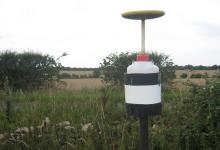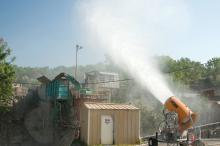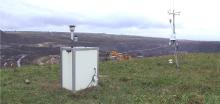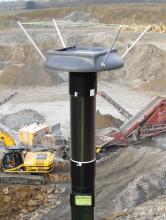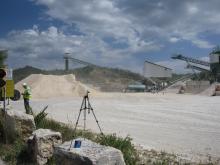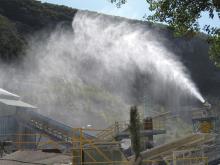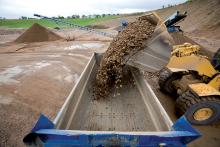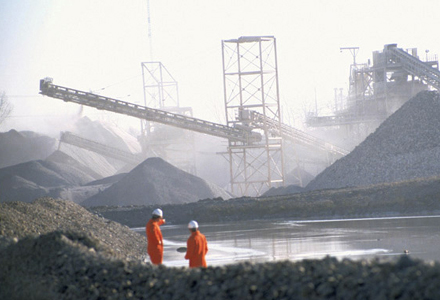
Dust can be a big problem for quarries but careful monitoring is essential to find the right solution, according to SLR Consulting's Rachel Cutler
Noise, dust and vibration are all issues that can cause friction between quarry operations and the surrounding local communities and are all problems the quarrying industry is working to mitigate. Sources of noise and vibration can be fairly easily identified and isolated but preventing dust is more of a challenge as there can be multiple sources and deposition rates can be very weather dependent.
"To maintain good local relations and to ensure that residents are not affected by nuisance levels of dust, monitoring schemes are increasingly being written into planning conditions," explained
"For the majority of deposited dust monitoring schemes at quarry sites, passive monitors are the preferred option. These monitors are designed to collect deposited particulate matter (precipitated out from the air either by gravity or contact with water droplets) over a given exposure period, prior to laboratory analysis." Two parameters often used to measure deposited dust from passive methods are surface soiling and deposition rate. Surface soiling is the measurement of the amount of soiling of a surface and involves the physical coverage as well as taking into account the appearance of the particles, such as light scattering properties. Deposited dust only takes into account the mass of the deposit and provides a record of the average deposition rate.
Automatic systems available for monitoring deposited dust are often very expensive and involve preparation in the field and access to power supplies. Continuous samplers such as Tapered Element Oscillating Microbalance (TEOM) samplers are often used in circumstances where real time results are required to give a rapid response time.
A number of simple, cost effective, monitoring schemes that provide robust and reliable results and which can be operated by on site personnel are available.
"At Must Farm, a sand and gravel quarry operated by
"Following correspondence with the local authority, a monitoring scheme of four boundary monitoring locations was agreed which would assess dust levels at local receptors.
"The passive technique of an omni-directional frisbee gauge provided the main structure of the monitor. It collected deposited dust in an up-turned frisbee shape in which dust settled and washed into a collection bottle.
"Every four weeks, the bottle was replaced and the contents from the bottle were analysed by a UKAS accredited laboratory to produce a dust deposition rate in terms of mg per square metre per day for each location.
"To increase the effectiveness of this method, an adhesive pad was attached to the shaft of the Frisbee gauge. This pad was able to capture dust flux as well as indicating the primary direction from which dust was originating.
"With this monitoring scheme in place, the results provided a monthly average deposition rate, the amount of surface soiling and directional data to help identify the source of the dust. Directionality of dust is of particular relevance when the operator is alleged to be causing the nuisance as it can, in many cases, demonstrate that a reasonable proportion of coarse dust particles originate from adjacent activities such as farming or transport."
Monitor selection
Deciding which dust monitor is most suitable for a site depends on many factors. As cost effectiveness is often a primary operator concern, involving site staff in the monitoring scheme can be a way of significantly reducing the financial outlay involved.
At Hanson's Must Farm, SLR carried out the preparation for the dust monitoring scheme while also training members of site personnel on how to operate the equipment, overcome problems and send off samples to an accredited laboratory. SLR continues to monitor the results, produce summary reports and provide support for site staff undertaking the monitoring.
"The location of dust monitors is dependent on a number of factors, including the proximity to dust sensitive locations, the views of the local authority, the objectives of the scheme and logistical factors, such as accessibility and the risk of vandalism," said Cutler.
The strategy adopted at Smith and Sons (Bletchington) Ltd's Whitehill Quarry in Burford, UK located the monitors as close to the two nearby residential properties as practicably possible. The residents agreed to the installation of the dust monitors within their grounds to both reduce the risk of vandalism and also provide representative results of the dust impacts being experienced at each receptor.
Locating of dust monitors is very much dependent on site specific circumstances; monitors may be more appropriate at locations on site, off site or a mixture of both. A mixture of on site and offsite monitoring locations was the approach undertaken at Burford Quarry and four monitoring points located around the site boundary as well as at surrounding residential properties were used.
Background levels
Baseline monitoring schemes can be useful to operators in areas where alternative dust sources are present, such as agriculture or transport. If dust monitoring only starts once the quarry site is in operation, elevated levels may be attributed to the quarry - although a high proportion may be background concentrations.
Many planning conditions require the operator to implement a dust monitoring scheme for a minimum of three months prior to aggregate extraction getting underway. This enables a dataset of baseline dust levels for which a comparison can be made once operations start.
Real results
"Often the two main parameters local authorities request are the rate of dust deposition (mg/m2/day) and surface soiling - percentage of effective area covered (EAC)," said Cutler. "There are no statutory EU standards for the control of nuisance dust. In the absence of such standards, the custom and practice guideline for dust deposition used in the UK is 200mg/m2/day. Levels above this should trigger an action by the operator to mitigate the dust source.
"Similar to dust deposition rates, there are no standard guidelines for what corresponds to an unacceptable level of surface soiling when using such methods as adhesive pads. Studies undertaken provide guideline values to correspond with public perceptions. For example, a surface soiling level of 0.5% EAC per day can be corresponded to a possible complaint while 2% EAC corresponds to a probable risk of complaint.
"The results of dust monitoring schemes can often raise questions over the alleged source of the dust. In many cases, the rural locations of a quarry site means a sizeable proportion of the dust deposited is from adjacent activities such as farming. In addition to directional sampling, if further information is required, additional analysis can be performed on dust samples to assess the colour, size fraction and mineralogy to trace the source."

